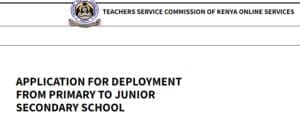*Report reveals how two communities dominate top cadre jobs in state agencies*
According to a report submitted to Parliament, two communities dominate the top cadre positions in state agencies, leaving the others to compete for the few remaining openings.
The reports that the various heads of state agencies submitted to the National Assembly Committee on National Cohesion and Equitable Cohesion show that Kalenjins and Kikuyus make up the largest percentage of personnel in all the agencies that have been so far studied.
The committee chaired by Mandera West MP Adan Haji is currently meeting all state agencies to check the ethnic composition of their employees in order to determine whether they comply with Section 7 of the National Cohesion and Integration Act, which states: “No public establishment shall have more than one-third of its staff from the same ethnic community.”
Section 7(1) and (2) of the Act states that all offices shall seek to represent the diversity of the people of Kenya in the employment of staff and no public institution shall have more than one-third of its staff from the same community.
In the Teachers Service Commission (TSC), out of 2,842 of its secretariat staff, Kikuyus have the highest number at 545, followed by Kalenjins with 412, Kamba are third with 323, Luhyas come fourth with 318 while Luos closes the top five with 266.
The documents tabled by CEO Nancy Macharia show that, out of the 1,077 secretariat staff at the middle level at TSC, Kikuyus are 316, followed by the Kalenjins (131), Kambas (127), Luhyas (103), and Meru (89).
Ms. Macharia defended the distribution, saying, at the secretariat level, it’s about technical know-how and specialization in a given area. She said one has to be highly competitive in order to make it at that level.
According to the TSC report, out of the 346,760 registered teachers in the country Kalenjins have the highest number at 59,538 followed closely by the Kikuyus at 59,010, Luhyas comes third with 52,882 followed by Luos at 40,657 and Kambas five with 39,807.
In the ethnic distribution of teachers *in the senior management level in primary schools, Kalenjins top the list with 6,159 followed by Kikuyus with 5,159, Kambas are third with 5,122, Luhyas comes fourth with 4,653 while Luos are at number five with 4,500.
The Kikuyu have the most teachers in post-primary schools with 3,493 followed by Luhyas (2, 736), Kalenjins (2,063), Luos (2,055), Kisiis (1,323) and Kambas (1,950).
At the lower level, Kalenjins still lead in the ethnic distribution of teachers in primary schools with 24,144, followed by Luhya (21,943), Kikuyus (21,540), Luos (16,574), and Kambas (16,532).
According to data presented before the committee, out of the 540 employees currently employed by the Kenya Electricity Transmission Company (Ketraco), the majority of the employees are from the Kalenjin, Kikuyu, Luos, Kamba, and Meru groups.
The ethnic distribution matrix presented by interim managing director Issac Kiva shows that Kalenjins make up 125 people, or 24 percent of the entire workforce, followed by Kikuyus at 90 people, or 17 percent, Luos at 65, Kambas at 49, and Merus at 20.
*The communities with the fewest employees in the parastatal are* Dasemach, Dorobo, Kuria, Pokomo, Taveta, and Turkana, each of which has just one worker.
Overall, Ketraco has 370 male employees (71 percent) and 150 females (29 percent).
The documents show that, out of the mass recruitment of 158 people in the last three years, Kalenjins took the lion’s share with 57 people, followed by Kikuyus (24), Luhyas (21), Luos (20 ) and Kambas (14).
Kikuyus make up 649 out of the 1,404 employees at Kenyatta University Teaching, Referral, and Research Hospital, or 46.23 percent of the total workforce.
Documents presented to the committee by KUTRRH CEO Ahmed Dagane reveal that Luhya community members came in a distant second with 123 employees (8.7%), followed by 111 Luos (7.9 percent).
At Kenya Rural Roads Authority (Kura), out of its 747 staff across various cadres, 235 employees are from the Kikuyu community, translating to 31.5 percent, followed by Kalenjins with 102 or 13.5 percent of the workforce. Luhyas are third with 84 employees with the Luos coming fourth with 83 employees.
The Kamba have 67 followed by Kisiis (54), Meru (34), and Maasai and Taita 10 each.
Documents tabled by Director General Philemon Kandie indicate that at the senior management level , Kikuyus occupy 16 translating to 38.2 percent, followed by the Kalenjins with six or 15 percent. Both the Kamba and Luhyas have five workers each in top management, translating to 12.5 percent.
In the mass recruitment carried out in 2022, out of the 168 people employed, 38 were Kalenjins, followed by Kikuyus at 36, Luos (17), Kambas (16), and Luhyas (15).
Kisiis had 11 while Merus had 10.Others, such as the Maasai, Somali, Swahili, Suba, Taita, Teso, Mbeere, and Mjiknda, had less than ten recruited.





